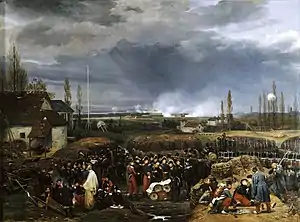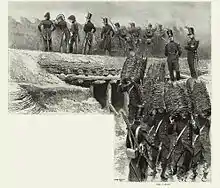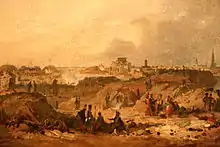Siege of Antwerp (1832)
The Siege of Antwerp took place after fighting in the Belgian Revolution ended. On 15 November 1832, the French Armée du Nord under Marshal Gérard began to lay siege to the Dutch troops there under David Chassé. The siege ended 23 December 1832. The French had agreed with the Belgian rebels that the latter would not participate in the battle.[1]
| Siege of Antwerp | |||||||
|---|---|---|---|---|---|---|---|
| Part of the aftermath of the Belgian Revolution | |||||||
 Siege of the citadel of Antwerp, December 22, 1832 | |||||||
| |||||||
| Belligerents | |||||||
|
|
| ||||||
| Commanders and leaders | |||||||
|
|
| ||||||
| Units involved | |||||||
| Armée du Nord | |||||||
| Strength | |||||||
| 4,500[1] | |||||||
| Casualties and losses | |||||||
| 370 dead[2] | 560 dead[2] | ||||||


Following the French army's first intervention in 1831, the Dutch withdrew from Belgium but left a garrison in Antwerp Citadel, from which they bombarded the town. The Armée du Nord and its siege specialist François, Baron Haxo took 24 days to take this citadel and return it to Belgium. Leopold I of Belgium gave France several cannons of different calibres as thanks for this action and the French Chamber of Peers offered Gérard an épée d'honneur ("sword of honour"). A monument to the French dead in the siege was sculpted in 1897, but the town of Antwerp refused to take it and it is now in Tournai.
Background
When the Dutch withdrew from Belgium after the campaign called the Ten Days' Campaign, they left a garrison in the citadel of Antwerp, which resulted in a second operation of the Armée du Nord of Marshal Gérard, who returned with his army to Belgium November 15, 1832, when he laid siege to Antwerp.
The Dutch general Chassé, who participated in the defeat of the French Imperial Guard at Waterloo in 1815, bombarded the city of Antwerp from the fort using heated shot, setting fire to hundreds of homes and causing many casualties among the civilian population. This caused the intervention of the Belgian volunteers who until then had been kept out of combat. Meanwhile, the Belgian army, gradually formed and re-equipped, went to defend the dikes of the Scheldt north of Antwerp, preventing the Dutch from damaging them.
Siege
For several decades, the siege tactics of the Vauban fortresses were limited to the method of the saps and parallels, usually causing the surrender of the besieged soon after the fortifications were pierced. The Armée du Nord conceived of the idea of using large mortars to fire shells into the fortress from above.
Commemoration and legacy
Leopold I gave several guns of various calibers to France and Marshal Gerard received a sword of honor offered by the King and the Belgian government in gratitude. The French Monument, carved in 1897 to celebrate the memory of French soldiers who fell for the capture of Antwerp in 1832, is currently in Tournai following the refusal of the city of Antwerp to accept it.[3]
In June 1837, to celebrate the marriage of the Duke of Orleans, the Champ de Mars in Paris served to represent the scene of the mock capture of the citadel of Anvers.[4]
References
- Siege of Antwerp (1832) Archived 2011-07-24 at the Wayback Machine (pdf-file) nl (Legermuseum)
- Extra Le Vif/L'Express, "Les documents inédits de notre histoire", 26 janvier 2010
- La Ville de Tournai fut choisie pour deux raisons. Parce qu’Anvers n’a pas accédé au souhait émis en 1894 par des bourgeois bruxellois d’y faire ériger un monument en l’honneur des 871 soldats français tués, blessés ou restés invalides durant le siège en 1832. Et ensuite parce que la Ville de Tournai a accédé au souhait du Comité Bruxellois auquel s’était joint un Comité Tournaisien, du fait que c’est par Tournai que le corps expéditionnaire français était entré en Belgique pour aller assiéger Anvers. Hommage aux soldats français, discours d’André Bruneau, Président du Comité FNACA de Belgique, 21 septembre 2008.
- de Gaulle, Jules P. (1839). Nouvelle histoire de Paris et de ses environs. Paris: Pourrat. pp. 393–394.
Further reading
- Chevalier de Richemont (1833). Siège de la citadelle d'Anvers, par l'armée française, sous les ordres du maréchal comte Gérard (in French).
- "The Siege of Antwerp in 1832". The United Service Magazine: 289–392. 1833.
- "The Military Organization of Belgium". The United Service Magazine: 8–20. 1833.